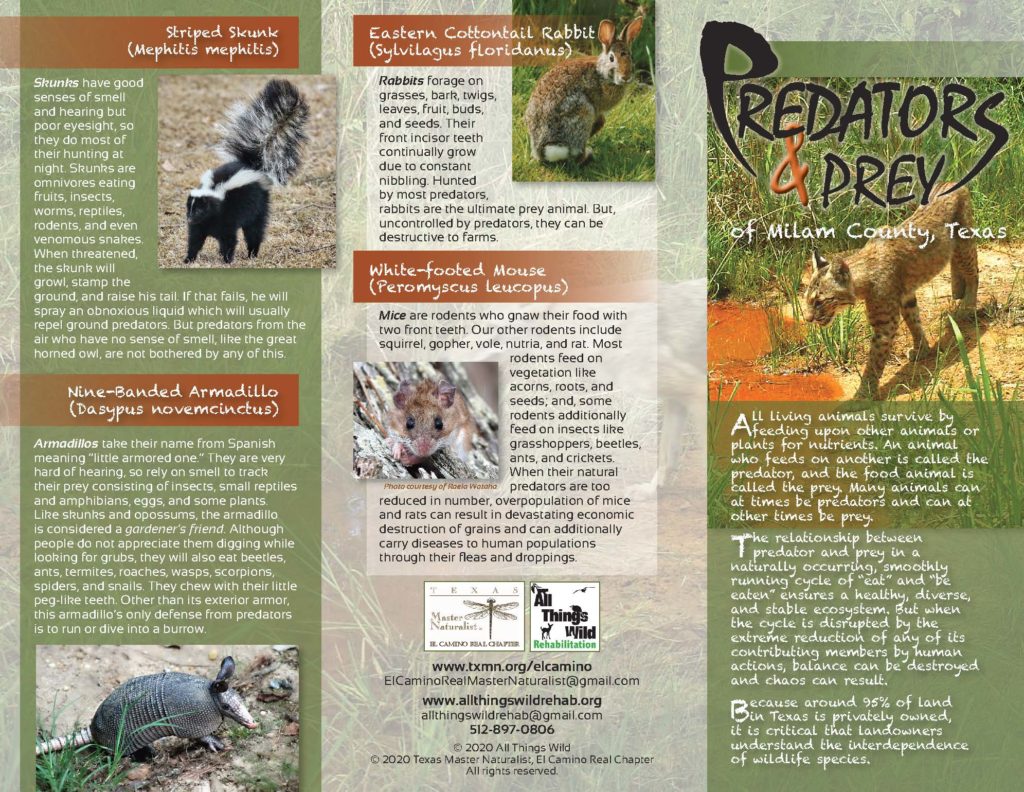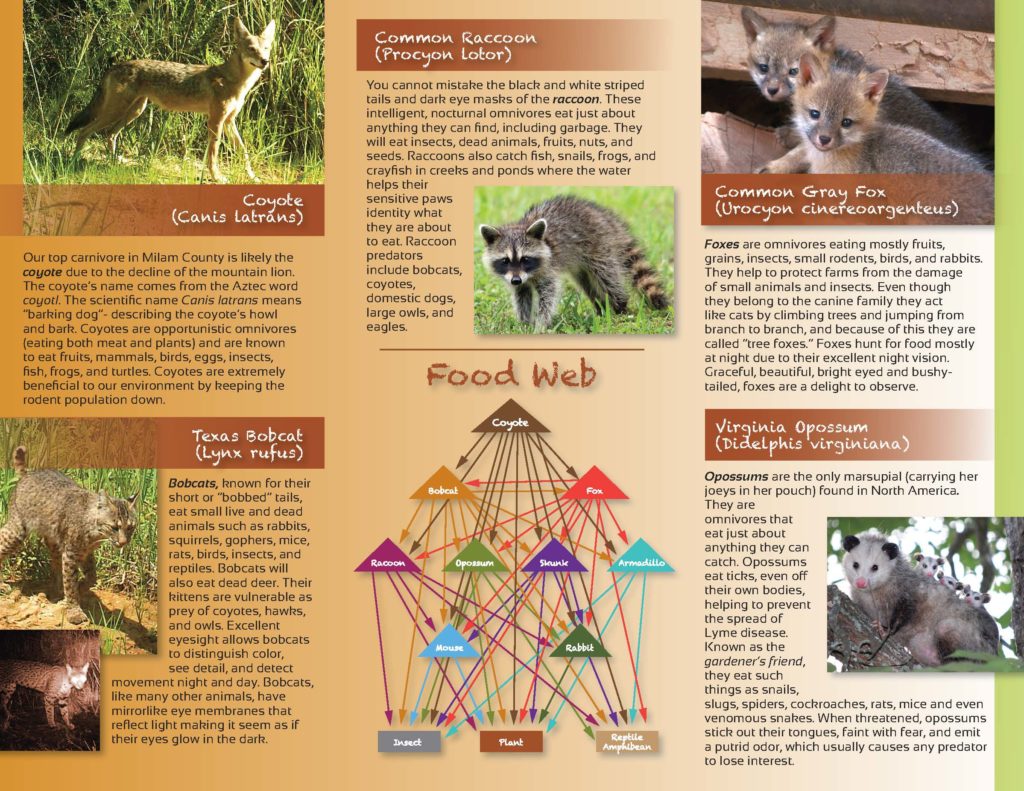Animals, Animals and more Animals
From Wikipedia:
Class Presentations
2008 – 2009 Class – Mammalogy, Dr. John YOung, TPWD
2012 Class – Mammalogy, John Tomecek – TMN – Mammalogy Presentation
2018 Class – Mammalogy, Chris Harper, FWS Mammalogy Feb 2018
2020 Class – Mammalogy, Chris Harper, FWS Mammalogy_rev_Feb2020,
and coyote video at https://www.youtube.com/watch?v=2IHJ_HIPFMg
2022 Class – Mammalogy, Chris Harper, FWS Mammalogy_rev_April 2022
Other Mammal Presentations
- Conservation status of plains spotted skunk in Texas, by Clint Perkins May 2017
- Bats – our wonderful flying mammals. Bats 2013 Advanced Training by Cindy Bolch
- BATS for library presentation July 2017, Cindy Bolch
- Watch the live Bracken Cave “Batcam”, a few hours before dusk each evening, and see them return at sunrise the next morning.
- Feral Hog Control, by Mike Mitchell Download the Feral Hog Control PDF file
- Feral Hog online webinar by Billy Higgenbotham, covers everything – excellent: 1 hour 17 minute video
- The damage Feral Hogs can do to native habitats: Feral hogs negative affects, by Texas AgriLife
- The Feral Hog problem – a one page summary, by Don Travis
- Feral Hogs are the most reproductive mammal – 1 feral hog sow can be “responsible” for creating over 128,000 hogs in just over 5 years! Don’t believe it? Check out this sow reproduction spreadsheet and play with the assumptions and see what results you get. The details behind it are tedious but it is all laid out for your review. Even if this mathematical calculation differs from reality by 50%, that’s still a huge number.
Land Stewardship Assistance in Houston Toad Habitat
Several members attended this 1/2 day session at McKinney Roughs. The purpose of the program was to describe the current situation of declining Houston Toad habitats, how the Landowner Incentive Program has helped in the Lost Pines area of Bastrop County, and how it can help in other areas, including Milam County. Individual presentations are included below.
- Program Agenda
HT Landowner Workshop 2010 PDF file - Current Status and Habitat Issues
Houston Toad Overview Status PDF file - Habitat Improvement Practices
Houston Toad Habitat Management PDF file - Lost Pines Habitat Conservation and Landowner Incentives
Lost Pines Habitat Conservation PDF file - Natural Diversity Database
Natural Diversity Database PDF file - Carbon Credits, an opportunity for forest owners
Carbon Credits PDF file - Landowner Incentive Program
Landowner incentive program PDF file - Texas Animal Tracks
A brief two page publication by Texas Parks and Wildlife on the tracks of 9 common mammals in our area.
Texas animal tracks PDF file
Predators & Prey Brochure – A joint project between our El Camino Real Chapter and All Things Wild Rehabilitation, Inc. In 2020 the El Camino Real Chapter and All Things Wild partnered to create a brochure titled “Predators and Prey,” which is geared towards educating the public about some interesting things regarding wildlife, specifically in Milam County. Many of our wildlife creatures are sometimes mistakenly considered pests when actually these animals are quite beneficial to humans and the environment. These brochures are being distributed all over Milam County. Download the brochure PDF from here, and print your own copy (landscape and flip on short side). For a more complete story see our Blog here.
- See All Things Wild Rehab website for their newsletters, how to get rehab help, and much more. http://allthingswildrehab.org/
- Texas Wildlife texas-wildlife.org/
- For the comprehensive story on the latest Feral Hog issues and solutions, see Feral Hogs at TAMU.
- USDA Feral Swine Managing web site.
- A major resource on Feral Hog biology, history, management and control is http://articles.extension.org/feral_hogs
- Book “Animal Tracks of Texas”
- Mammals of Texas – Online, Schmidly’s online version
- Book “Mammals of Texas”, 2004 revised, by Schmidly, UT Press
- “Trackers Field Guide”, by Lowery, on Amazon
- “National Audubon’s Field Guide to N.A. Mammals”, on Amazon
- The NEW Bat-Watching Sites of Texas website is now live!!
- Bat Conservation International Website
- Bat Conservation and Management, a very good Pennsylvania web site
- TED Talk by Emma Teeling – The secret of the Bat Genome
- Make a Green Tree Fog Tube – https://www.youtube.com/watch?v=smQtNmHqOYo&ab_channel=TexasParksandWildlife
From Shawn Walton’s Weekly Blog / Column in Rockdale and Cameron Newspapers:
- 06.08.09_Frogs and Toads
- 08.24.09_Coyote
- 09.07.09_Bobcats
- 10.21.09_Red Bat
- 11.04.09_Red fox
- 11.11.09_White Tailed Deer
- 12.02.09_Pocket Gopher
- 12.24.09_Ringtail Cat
- 12.30.09_Raccoon
- 02.03.10_Striped Skunk
- 06.03.10_Mexican free-tailed Bat
- 07.01.10_Armadillos
- 10.21.10_Panther
- 02.03.11_Evening Bat
- 03.24.11_Porcupine
- 05.26.11_Squirrels




